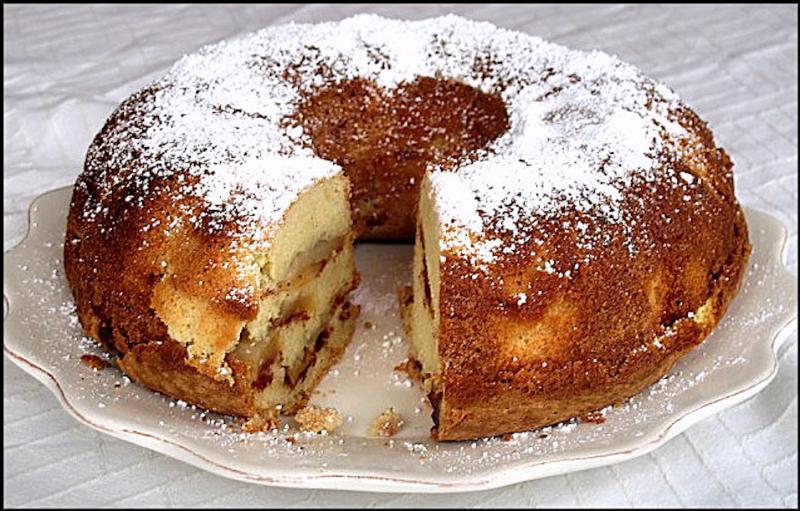Apple cake is a tasty way to enjoy bountiful fall crops
It would seem that every newspaper food editor and online recipe blogger across the country received the same memo: Write about apples this week. One of the articles that intrigued me appeared in the Washington Post under the title “Jewish Apple Cake.” The author, Becky Krystal, described the history of her family’s recipe and her efforts to identify the possible originator of the specific ingredients and instructions.
Two key features of the recipe are orange juice as flavoring and vegetable oil as the fat (instead of butter) to adhere to Jewish dietary laws. While her search uncovered many similar recipes in a range of cookbooks and cooking columns ranging from the 1970s through today, its roots are most likely in the Eastern European ancestors of Jewish immigrants to this country.
As I read through her recipe, I was struck by the extremely small quantities of both juice and oil included. Whenever I see oil as a cake ingredient, I assume it is going to become a chiffon cake. In these, at least a half-cup of oil and separately beaten egg whites are used to create a tender and very light texture (hence the name). Baking powder and the meringue provide generous leavening to a chiffon cake.
The other difference was her use of cooking spray to coat the inside of a Bundt pan. Chiffon cake recipes use an ungreased tube pan to give the batter purchase on the surface and better leverage to rise. I followed the apple cake recipe and the results were very tasty, but the cake didn’t rise as high or deliver as delicate a texture as a chiffon cake.
Prepping the apples for the batter was the longest step in making the cake; Krystal’s recipe called for them to be peeled, cored and sliced. The slices were then arranged in an overlapping layer on top of the first portion of batter poured into the pan. The next step was to liberally sprinkle the apple slices with cinnamon sugar. I would have tossed them together in a bowl, giving the sugar mixture a chance to melt around the apples.
One change I did make to her instructions was to divide the batter into thirds, so that the top (going into the oven) was batter, not sugary apples, which might burn. This also meant the bottom (after coming out of the pan) was cake, instead of an uneven layer of apples. What you can’t see in the photo is the partial deconstruction of my cake that occurred when I tried to remove it from the pan. Confectioner’s sugar was deployed as camouflage.
A missing piece in the long article about her family recipe for apple cake was any mention of the best variety of apple to select. If you’ve been to a famers market, a roadside produce stand or even a grocery store recently, you’ve seen the wide array of apple choices, from the familiar Gala to tart Granny Smith, which would both be fine for baking.
However, if you want to add something special to your apple cake, consider Jonagold. This apple is tart with a honeyed sweetness and will maintain a firm texture when baked. Another good choice is Honeycrisp, for the same qualities. Avoid the sometimes-mealy Delicious and the too-tart MacIntosh.
For your baking inspiration, I’ve included my adaptation of Krystal’s Jewish Apple Cake and an orange-infused chiffon cake that is so sweet you don’t need to add confectioner’s sugar (unless it breaks coming out of the pan and you want some camouflage).
Jewish Apple Cake*
3 large apples
2 T cinnamon
1/4 C sugar
3 C flour
1 T baking powder
1/2 t salt
2 C sugar
4 large eggs
1/3 C canola oil
1 T vanilla
1/3 C orange juice
confectioners sugar, for dusting
Preheat oven to 350 F. Generously coat the inside of a Bundt pan with nonstick cooking spray; set aside. Peel, core and thinly slice the apples. Place in a bowl and toss with cinnamon and sugar; set aside. Whisk together flour, baking powder and salt in a bowl; set aside. In a large mixing bowl, combine the 2 C sugar with eggs and oil. Beat on medium until thick and creamy, about 3 minutes. Add vanilla and mix to combine. Add a third of the flour mixture and a third of the orange juice; beat well to combine. Repeat twice more. Pour one-third of the batter into the prepared pan and smooth with a spatula. Arrange half the apples in an overlapping layer to cover the batter. Pour in another third of the batter and add the remaining apples. Cover apples with remaining batter and smooth with a spatula. Bake until a cake tester comes out clean, about 60 minutes. Allow to cool for about 10 minutes before using a knife to separate the cake from the sides of the pan. Turn cake out onto a rack to cool completely. Dust the top with confectioners sugar before serving. *Adapted from Becky Krystal in the Washington Post.
Orange Chiffon Cake
2 1/4 C cake flour
2 t baking powder
1 t salt
1 1/4 C sugar
6 eggs, separated
1/2 C canola oil
1 C orange juice
2 t vanilla
1/2 t cream of tartar
1/2 C sugar
Preheat oven to 325 F. In a large bowl, stir together flour, baking powder, salt and 1 1/4 C sugar; set aside. In a mixing bowl, beat together egg yolks, oil, juice and vanilla until smooth. Pour the egg yolk mixture into the flour mixture and stir to thoroughly combine; set aside. Place egg whites and cream of tartar in a scrupulously clean metal or glass bowl. Beat on medium until foamy, then gradually increase speed to medium high. Add 1/2 C sugar a little at a time, beating well after each addition. Continue mixing egg whites until stiff peaks form, and they appear thick and glossy. Gently fold the egg whites into the batter just until combined. Pour batter into a 10-inch tube pan and bake until surface appears dry, about 50 to 55 minutes. Remove pan from the oven and invert onto a can or bottle. Allow to cool completely before running a knife along the inside of the pan to release the cake onto a serving platter.























































